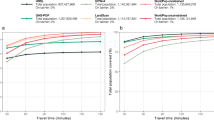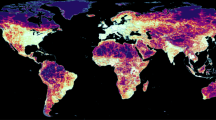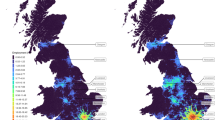Abstract
Background/objective
Lack of access to resources such as medical facilities and grocery stores is related to poor health outcomes and inequities, particularly in an environmental justice framework. There can be substantial differences in quantifying “access” to such resources, depending on the geospatial method used to generate distance estimates.
Methods
We compared three methods for calculating distance to the nearest grocery store to illustrate differential access at the census block-group level in the Atlanta metropolitan area, including: Euclidean distance estimation, service areas incorporating roadways and other factors, and cost distance for every point on the map.
Results
We found notable differences in access across the three estimation techniques, implying a high potential for exposure misclassification by estimation method. There was a lack of nuanced exposure in the highest- and lowest-access areas using the Euclidean distance method. We found an Intraclass Correlation Coefficient (ICC) of 0.69 (0.65, 0.73), indicating moderate agreement between estimation methods.
Significance
As compared with Euclidean distance, service areas and cost distance may represent a more meaningful characterization of “access” to resources. Each method has tradeoffs in computational resources required versus potential improvement in exposure classification. Careful consideration of the method used for determining “access” will reduce subsequent misclassifications.
This is a preview of subscription content, access via your institution
Access options
Subscribe to this journal
Receive 6 print issues and online access
$259.00 per year
only $43.17 per issue
Buy this article
- Purchase on Springer Link
- Instant access to full article PDF
Prices may be subject to local taxes which are calculated during checkout





Similar content being viewed by others
References
Sexton K. Socioeconomic and racial disparities in environmental health: is risk assessment part of the problem or part of the solution? Hum Ecol Risk Assess Int J. 2000;6:561–74. http://www.tandfonline.com/doi/abs/10.1080/10807030008951330.
Lee C. Environmental justice: building a unified vision of health and the environment. Environ Health Perspect. 2002;110 SUPPL. 2:141–4.
Walker RE, Keane CR, Burke JG. Disparities and access to healthy food in the united states: a review of food deserts literature. Heal Place. 2010;16:876–84. https://doi.org/10.1016/j.healthplace.2010.04.013.
Morland K, Wing S, Diez Roux A, Poole C. Neighborhood characteristics associated with the location of food stores and food service places. Am J Prev Med. 2002;22:23–9.
Phibbs CS, Luft HS. Correlation of travel time on roads versus straight line distance. Med Care Res Rev. 1995;52:532–42. http://journals.sagepub.com/doi/10.1177/107755879505200406.
Shahid R, Bertazzon S, Knudtson ML, Ghali WA. Comparison of distance measures in spatial analytical modeling for health service planning. BMC Health Serv Res. 2009;9:200. https://bmchealthservres.biomedcentral.com/articles/10.1186/1472-6963-9-200.
Li Y, Luo M, Wu X, Xiao Q, Luo J, Jia P. Grocery store access and childhood obesity: a systematic review and meta‐analysis. Obes Rev. 2019;obr.12945. https://onlinelibrary.wiley.com/doi/abs/10.1111/obr.12945.
Sparks AL, Bania N, Leete L. Comparative approaches to measuring food access in urban areas: the case of Portland, Oregon. Urban Stud. 2011;48:1715–37.
Costa BVL, Menezes MC, Oliveira CDL, Mingoti SA, Jaime PC, Caiaffa WT, et al. Does access to healthy food vary according to socioeconomic status and to food store type? an ecologic study. BMC Public Health. 2019;19:1–7.
Caspi CE, Kawachi I, Subramanian SV, Adamkiewicz G, Sorensen G. The relationship between diet and perceived and objective access to supermarkets among low-income housing residents. Soc Sci Med. 2012;75:1254–62. https://doi.org/10.1016/j.socscimed.2012.05.014.
Apparicio P, Cloutier MS, Shearmur R. The case of Montréal’s missing food deserts: Evaluation of accessibility to food supermarkets. Int J Health Geogr. 2007;6:1–13.
DataAxle. Leading business and consumer data for libraries and their patrons. 2020. https://www.data-axle.com/what-we-do/reference-solutions/.
Centers for Disease Control and Prevention. Census tract level state maps of the modified retail food environment index. Children’s Food Environ State Indic Rep. 2011;2011:53. https://perma.cc/79QP-QTWF.
Schiavina M, Freire S, MacManus K. GHS-POP R2019A—GHS population grid multitemporal (1975-1990-2000-2015). Jt Res Centre Eur Comm. 2019. https://data.europa.eu/euodp/en/data/dataset/0c6b9751-a71f-4062-830b-43c9f432370f.
Gridded Population of the World, Version 4 (GPWv4): Population Count, Revision 10. Palisades, NY: 2018.
Laurini R, Thompson D. Fundamentals of spatial information system. The APIC S. London: Academic Press; 1992.
OpenStreetMap Contributors. Planet dump retrieved from https://planet.osm.org. OpenStreetMap. 2020.
R Core Team. R: a language and environment for statistical computing. Vienna, Austria: 2020.
Fisher R. Intraclass correlations and the analysis of variance. In: Statistical methods for research workers. Edinburgh: Tweeddale Court: Oliver and Boyd; 1934. p. 156. http://www.haghish.com/resources/materials/Statistical_Methods_for_Research_Workers.pdf.
Funding
Funding for this work was provided by Sharecare Inc (https://wellbeingindex.sharecare.com/).
Author information
Authors and Affiliations
Contributions
ANS and KS had full access to all the data in the study and take responsibility for the integrity of the data and the accuracy of the data analysis. Concept and design: ANS, KS, and KJL. Acquisition, analysis, or interpretation of data: ANS, KS, and BW. Drafting of the paper: ANS, KS, and KJL. Critical revision of the paper for important intellectual content: All authors. Final approval of version to be published: All authors. Agreement to be accountable for all aspects of the work in ensuring that questions related to the accuracy or integrity of any part of the work are appropriately investigated and resolved: All authors.
Corresponding author
Ethics declarations
Competing interests
The authors declare no competing interests.
Additional information
Publisher’s note Springer Nature remains neutral with regard to jurisdictional claims in published maps and institutional affiliations.
Supplementary information
Rights and permissions
About this article
Cite this article
Nori-Sarma, A., Spangler, K.R., Wang, B. et al. Impacts of the choice of distance measurement method on estimates of access to point-based resources. J Expo Sci Environ Epidemiol 33, 237–243 (2023). https://doi.org/10.1038/s41370-022-00414-z
Received:
Revised:
Accepted:
Published:
Issue Date:
DOI: https://doi.org/10.1038/s41370-022-00414-z
Keywords
This article is cited by
-
Evaluating Methods for Mapping Historical Redlining to Census Tracts for Health Equity Research
Journal of Urban Health (2024)
-
Urbanity: automated modelling and analysis of multidimensional networks in cities
npj Urban Sustainability (2023)



